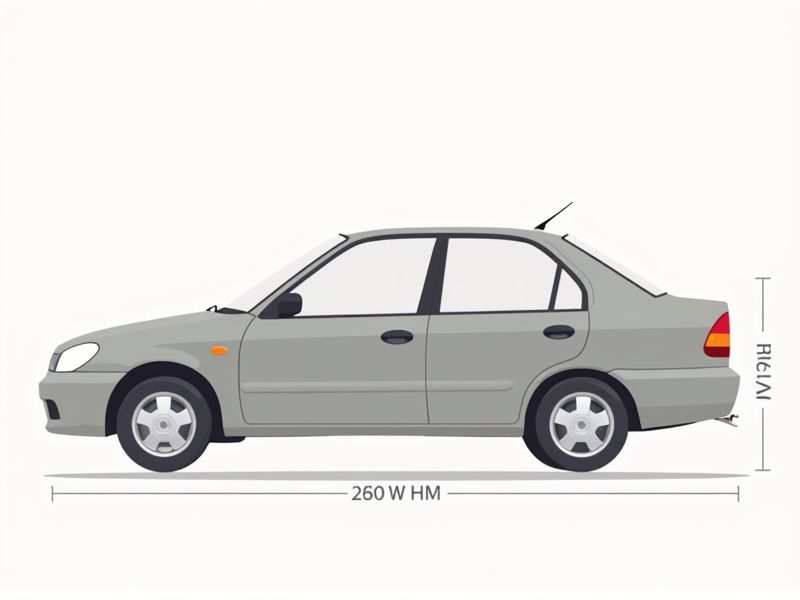
When considering the standard dimensions of a car, it's helpful to know that most average passenger vehicles are about 14 to 16 feet long (approximately 4.2 to 4.8 meters) and 5.5 to 6 feet wide (about 1.7 to 1.8 meters), not including mirrors. The typical car height is usually between 4.5 and 5 feet (around 1.4 to 1.5 meters). These dimensions can vary depending on the car type; for example, compact cars tend to be smaller, while SUVs and trucks are often larger in all aspects. Knowing these standard measurements can help you determine if a specific car will fit in your garage, parking spot, or conform to your local regulations.
Vehicle Length
The standard vehicle length for compact cars typically ranges from 14 to 16 feet, providing a balance between maneuverability and interior space. Mid-size vehicles often measure between 16 to 18 feet, accommodating families while maintaining efficient fuel consumption. Full-size cars generally exceed 18 feet, offering enhanced comfort and trunk capacity, ideal for long road trips. For optimal parking and city driving, choosing a vehicle with a length under 15 feet may significantly improve your experience.
Vehicle Width
Vehicle width is a crucial standard in automotive design, typically ranging from 1.6 to 2.0 meters for most cars. This dimension significantly affects not only the vehicle's aerodynamics but also its stability and handling characteristics during various driving conditions. A wider vehicle often provides enhanced passenger space and improved road grip, which can lead to overall better performance. Understanding vehicle width is essential for consumers when considering parking space and maneuverability in urban environments.
Vehicle Height
Vehicle height plays a crucial role in determining a car's aerodynamics and stability, significantly affecting fuel efficiency and handling. A standard height range for most passenger vehicles typically falls between 55 to 67 inches, optimizing performance while ensuring comfort. Sports cars often feature lower profiles, reducing wind resistance, while SUVs generally stand higher, enhancing visibility and off-road capability. When considering your next vehicle purchase, it's essential to evaluate how height aligns with your driving needs and preferences.
Wheelbase
The wheelbase of a car, typically ranging from 90 to 120 inches, significantly influences stability and handling. A longer wheelbase, often exceeding 110 inches, tends to provide a smoother ride, ideal for highway driving, while enhancing traction on uneven surfaces. Conversely, a shorter wheelbase, generally below 100 inches, allows for improved maneuverability and tighter turning radii, making it beneficial for city driving. Understanding wheelbase dimensions can help you select a vehicle that meets your driving needs and preferences.
Ground Clearance
Ground clearance plays a critical role in a vehicle's performance, particularly for off-road capabilities and ride comfort. Most standard cars have a ground clearance ranging between 5 to 6.5 inches, which is suitable for urban driving and occasional rough terrain. Higher ground clearance, typically found in SUVs, averages between 7 to 9 inches, allowing for better navigation over obstacles and improved approach angles. Ensure your car's ground clearance meets your driving needs, particularly if you frequently encounter uneven surfaces or unpaved roads.
Track Width
Track width, the distance between the centerlines of a vehicle's tires, is crucial for your car's handling and stability. In motorsport, a wider track width can enhance cornering performance by lowering the center of gravity and reducing body roll, with most racing vehicles featuring a standard track width between 60 to 80 inches. A typical passenger car has a track width ranging from 55 to 65 inches, which balances handling and comfort for everyday driving. Adjusting your car's track width may improve performance, but alterations must comply with regulations and safety standards for road use.
Trunk Capacity
A car's trunk capacity significantly influences its practicality and usability, especially for families and frequent travelers. Typically measured in cubic feet, most sedans offer between 12 to 16 cubic feet of trunk space, while SUVs and hatchbacks can range from 25 to over 60 cubic feet with rear seats folded down. For your specific needs, consider models like the Honda Accord, boasting around 16.7 cubic feet, or the Toyota RAV4, offering an impressive 37.6 cubic feet behind the seats. Proper trunk space allows for effortless packing of luggage, groceries, or sports equipment, enhancing overall driving convenience.
Passenger Cabin Volume
Passenger cabin volume is a crucial metric that measures the amount of space available for occupants inside a vehicle, typically expressed in cubic feet. For example, a compact car may offer around 85 to 90 cubic feet of passenger cabin volume, while mid-size SUVs can provide more than 100 cubic feet, accommodating additional passengers and cargo comfortably. Manufacturers focus on optimizing this space to enhance overall driver and passenger comfort, making features like legroom and headroom significant considerations in car design. Understanding the importance of passenger cabin volume can help you make an informed decision when choosing a vehicle that best fits your needs for space and comfort.
Cargo Volume
Cargo volume is a critical factor when evaluating a car's utility, particularly for families or those requiring extra storage space. Vehicles with designated cargo areas can range significantly in volume, with compact cars offering around 15 cubic feet to larger SUVs providing up to 80 cubic feet or more. When considering your options, be aware that certain models with innovative design features can expand cargo capacity through foldable seats or removable sections. Understanding these specifications ensures that you select a vehicle that meets your needs for versatility and practicality.
Front And Rear Overhang
The front overhang of a standard car typically ranges from 24 to 30 inches, while the rear overhang usually measures between 20 to 28 inches. These measurements influence vehicle stability and handling, affecting how the car performs during acceleration and braking. A shorter front overhang can enhance steering response, while a balanced rear overhang contributes to weight distribution and ride comfort. Understanding these dimensions can help you choose a vehicle that meets your driving preferences and needs effectively.
